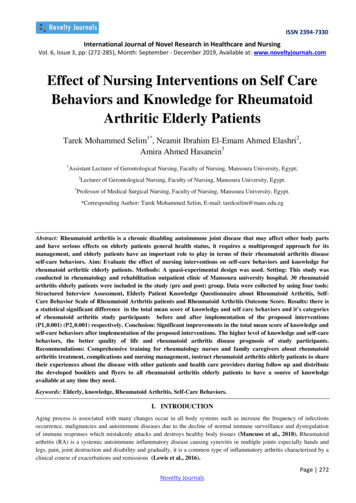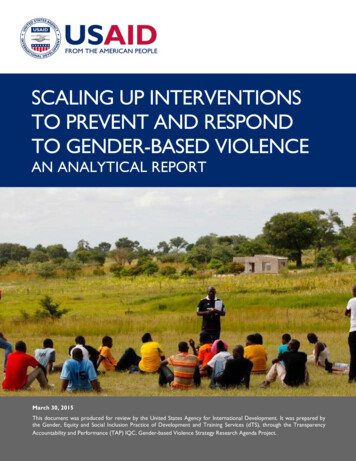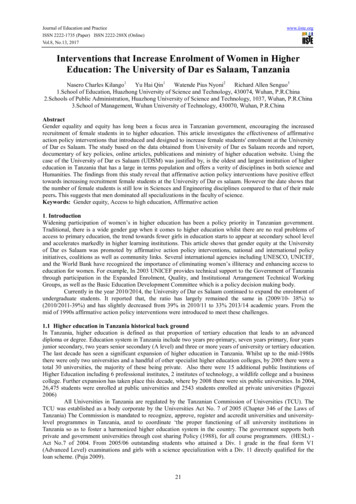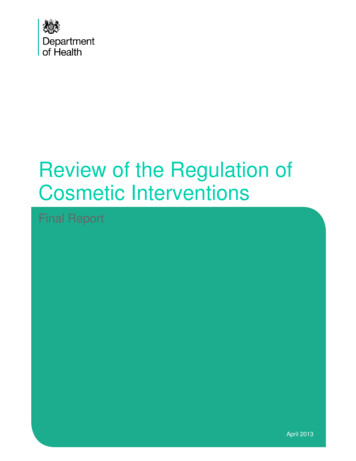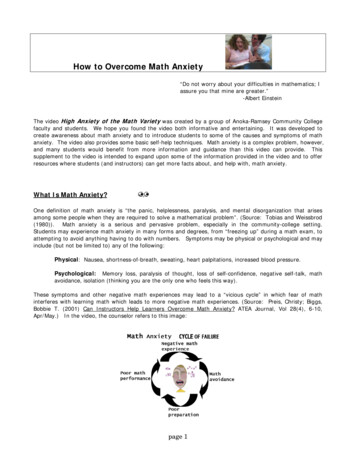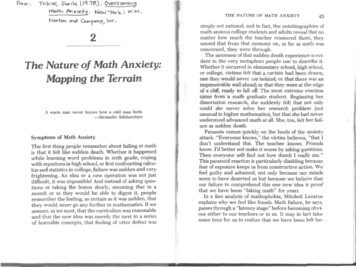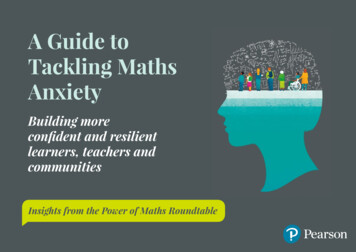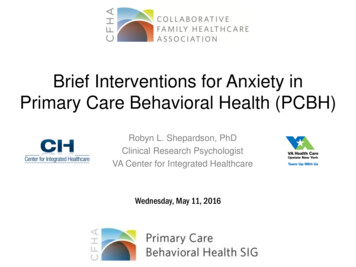
Transcription
Brief Interventions for Anxiety inPrimary Care Behavioral Health (PCBH)Robyn L. Shepardson, PhDClinical Research PsychologistVA Center for Integrated HealthcareWednesday, May 11, 2016
DisclosuresI have not had any relevant financial relationshipsduring the past 12 months.The views expressed in this presentation arethose of the author and do not reflect the official policyof the Department of Veterans Affairs or otherdepartments of the U.S. government
Acknowledgements Dr. Jennifer Funderburk Dr. Risa Weisberg RAs in Funderburk/Maisto lab VA Center for Integrated Healthcare
Learning ObjectivesAt the conclusion of this session, the participant will be able to: List six potential interventions for anxiety in PCBH Describe the main techniques involved in a variety ofbrief interventions for anxiety Locate numerous practice tools to support use of briefanxiety interventions
Overview Background on anxiety in primary care Limitations of existing ESTs for anxiety Key considerations when adaptingESTs for anxiety for PCBH 6 brief interventions for anxiety Final thoughtsVETERANS HEALTH ADMINISTRATION5
Primary CareBehavioral Health Model Population-based approach Behavioral health providers embedded into primary care BHPs serve as consultants to PCPs and are part of theprimary care team Time-limited, episodic care, often delivered in 1 to 4 15-30minute sessions Consistent with structure, goals, strategies, and culture ofprimary care, NOT traditional specialty mental health careVETERANS HEALTH ADMINISTRATION(Hunter & Goodie, 2010; Robinson & Reiter, 2015; Strosahl, 1996, 1998;Rowan & Runyan, 2005)6
Anxiety is Prevalentin Primary Care & PCBH 15-20% have any anxiety disorder Subthreshold anxiety also as common,if not more common Anxiety 2nd only to depression in reasonfor referral to PCBH MDD: 45% current, 70% lifetime Impairing and burdensomeVETERANS HEALTH ADMINISTRATION(Ansseau et al., 2004; Cwikel, Zilber,Feinson, & Lerner, 2008; Kroenke,Spitzer, Williams, Monahan, & Löwe,2007; Niesenson, Pepper, Schwenk,& Coyne, 1998)(Cwikel et al., 2008; Olfson et al.,1996; Rucci et al., 2003; Wittchenet al., 2002)(Auxier et al., 2012; Bryan, Morrow, &Appolonio, 2009; Cigrang et al., 2006;Funderburk et al., 2010)(Rodriguez et al., 2004)(Sherbourne et al., 2010;Stein et al., 2005)7
Limitations of Evidence-BasedAnxiety Treatment OptionsPharmacotherapy Many patients not open totaking medication Side effects Not advised for certainpopulations Not warranted for transient,situational, or mild symptomsVETERANS HEALTH ADMINISTRATIONPsychotherapy Most protocols are disorderspecific Developed for traditionalspecialty care model & format Not appropriate for PCBHsetting8
Adapting EST for Anxietyto Fit the PCBH SettingESTs for Anxiety Anxiety disorders share commonetiology, symptoms, maintainingprocesses, etc.– Cognitive: future-oriented,perceived threat– Behavioral: avoidance– Physiological: autonomic arousal similar treatment approach acrossdifferent anxiety presentationsPCBH Setting Population-based care Brief episodes of care Goals of improving function andreducing symptoms Patient education, activation,engagement in own health care education and targeted selfmanagement skills for at homepracticeGoals: Increase awareness and Teach coping skillsVETERANS HEALTH ADMINISTRATION(Norton & Philipp, 2008)9(Hunter & Goodie, 2010; Strosahl, 1996; Strosahl & Robinson, 2008)
6 Useful (and Brief)Interventions for PCBH Adapted from existing evidence-based interventions– Psycho-education– Mindfulness & acceptance based behavioral interventions– Relaxation training– Cognitive restructuring– Exposure– Behavioral activationVETERANS HEALTH ADMINISTRATIONFocus on: Adults andGAD, panic, social anxiety,phobias, adjustment, anxiety NOS(Not PTSD or OCD)10
Psycho-education Providing basic information about anxiety Can range from passive (e.g., a pamphlet) toactive (e.g., sessions led by therapist) Advantages– Increase patients’ knowledge about their conditionand correct their misperceptions– Less expensive than other approaches– Easy to administer– More accessible than therapy/meds Provides the rationale for other interventions Can yield small symptom reduction on its ownVETERANS HEALTH ADMINISTRATION(Donker, Griffiths, Cuijpers,& Christensen, 2009)11
Psycho-education for PCBH Topics to cover– Common symptoms– Anxiety spiral– Relationship between thoughts,feelings, & behavior– Prevalence (normalize)– Adaptive nature of anxiety & fear– Goals of treatmentVETERANS HEALTH ADMINISTRATION(figure from Asmundson, G. J., Taylor, S., Bovell, C. V., &Collimore, K. (2006). Strategies for managing symptoms of12anxiety. Expert Review of Neurotherapeutics, 6, 213-222.doi:10.1586/14737175.6.2.213)
Psycho-education for PCBHVETERANS HEALTH ADMINISTRATION(figure from P. Roy-Byrne et al. (2009). Brief intervention for anxiety in primary care patients.Journal of the American Board of Family Medicine, 22, 175-186. doi:10.3122/jabfm.2009.02.080078)13
Psycho-education Resources CIH handouts: Anxiety, Panic attacks, Action Plan for Anxiety, StressFact Sheet, Stress Response and How It Affects You, etc.–Patient education tab: www.mirecc.va.gov/cih-visn2/clinical resources.asp Other handouts–––––––Panic attack info: http://www.therapistaid.com/content/0148.pdfIntro to anxiety assessment: http://www.therapistaid.com/content/0048.pdfWhat is rumination?: ht or flight response: tmlSafety behaviors: .htmlBreathing: ings.htmlAnxious worry: Figure 5.2 in Hunter, Goodie, Oordt, & Dobmeyer (2009) ADAA website (Consumers section)– Overview: www.adaa.org/understanding-anxiety– Statistics: s– learn/webinarsVETERANSHEALTHADMINISTRATION– Videos: os14
Mindfulness and AcceptanceBased Behavioral Techniques Growing in popularity over last 15 years MABBTs emphasize:– Increasing awareness of present-moment experiences(Hayes, 2004; Roemer, Williston,– Practicing non-judgmental acceptanceEustis, & Orsillo, 2013; Vøllestad,Nielsen, & Nielsen, 2012)– Increasing values-driven actions Effective in reducing anxiety in SMH settings(Vøllestad, Nielsen, & Nielsen, 2012)– 8-16 sessions of 90-120 minutes Primary care setting– Recommended in clinical literatureVETERANS HEALTH ADMINISTRATION15
MABBTs adapted for PCBH Mindfulness– Simple mindful breathing exercise– What is mindfulness: � Mindfulness skills: r, Williston, Eustis, & Orsillo, 2013) Help get some space from anxiety (defusion)– Thoughts/Feelings Facts/Truth– e.g., “I’m having the thought that ” Highlight their agency and ability to pursue values– Past experience when they pushed through distress or discomfortVETERANS HEALTH ADMINISTRATION16
MABBTs adapted for PCBH Eliciting the patient’s values– Verbal inquiry, e.g., What matters most to you in your life?– List or worksheet http://www.therapistaid.com/content/0147.pdf http://psychology.tools/values.html Identify what valued activities are being avoided due to anxiety– Help them set 1-3 specific goals that would move them in thedirection of their priority values– Troubleshoot by identifying potential barriers and developingcorrespondingcoping strategiesVETERANSHEALTH ADMINISTRATION17
MABBTs adapted for PCBH(& Tobias Lundgren)123VETERANSHEALTHADMINISTRATIONNot at 5Consistent Remarkablyconsistent67VeryconsistentBull’seye!18
Relaxation Training EST for anxiety(Eppley, Abrams, & Shear, 1989; Manzoni,Pagnini, Castelnuovo, & Molinari, 2008) Teach patient to attend to and control their physiological arousal Variety of techniques–––––Diaphragmatic breathingProgressive muscle relaxationApplied relaxationAutogenic trainingTranscendental meditation Traditional protocols call for 8-15 50-minute sessionsVETERANS HEALTH ADMINISTRATION19
Relaxation TrainingAdapted to Fit PCBH Format Skill demo– Educate re: physiological relaxation response– Teach 1 skill via a 3-5 minute demo– Have patient rate tension or relaxation level before andafter on 0-10 scale to get data Address common issues––––Explain relaxation as a skill (like playing instrument)Plan when to do regular practiceGive written guide and/or audio aidProblem solve barriers (e.g., location, noise, thoughts) If skeptical– Normalize concerns– Note similar others’ success with itVETERANS HEALTH ADMINISTRATION– Propose trying it as experiment (now, and at home)20
Relaxation Training for PCBH Provide a menu of options– Deep breathing– Mindfulness meditation– Progressive musclerelaxation– Guided imageryVETERANS HEALTH ADMINISTRATION21
Relaxation Training Resources Encourage regular at-home practice and PRN use– Self-directed OR Guided by audio or video aid For you: Module 13 of Cully & Teten (2008) Brief CBT sts guide to brief cbtmanual.pdf For patients: handouts with instructions– CIH Patient Education Materials (Relaxation fact sheet, General relaxation exercise,Deep breathing, Abdominal breathing, Visualization guided imagery, Meditation, PMR):http://www.mirecc.va.gov/cih-visn2/clinical resources.asp– Relaxation exercises (deep breathing, imagery, �� PMR Script: http://www.therapistaid.com/content/0097.pdf ation.html– Relaxed breathing: http://psychology.tools/relaxed-breathing.html– Mindfulness exercises (mindfulness meditation, body scan, mindful eating, 5 dfVETERANS HEALTH ADMINISTRATION– Cue-controlled relaxation: Figure 3.2 in Hunter, Goodie, Oordt, & Dobmeyer (2009)22
Relaxation Training Resources Free mobile apps–––––––––Mindfulness CoachVirtual Hopebox (Relax Me)Tactical BreatherBreathe2RelaxHeadspaceCalmOMG I Can Meditate!CBT-I Coach (Tools Quiet Your Mind)PTSD Coach (Manage Symptoms Tools)VETERANS HEALTH ADMINISTRATION23
Relaxation Training Resources Websites with a good selection of audio files (with spokeninstructions and calming music) to guide patients throughvarious relaxation exercises– .html– http://www.dartmouth.edu/ healthed/relax/downloads.html– http://www.mckinley.illinois.edu/units/health ed/relax relaxation exercises.htm– ation.shtml– grams/mbsr/Pages/audio.aspx– http://marc.ucla.edu/body.cfm?id 22VETERANS HEALTH ADMINISTRATION24
Cognitive Restructuring Learn to identify and evaluate the accuracy of negative(Arch & Craske, 2009;Beck & Dozois, 2011)thoughts and develop alternative thoughts Address cognitive distortions Automatic thoughts, thought records,downward arrow exercises, behavioralexperiments to test hypotheses, etc. Efficacious across anxiety disorders(Norton & Price, 2007) BUT usually delivered in 12 to 24 50-minute sessionsVETERANS HEALTH ADMINISTRATION(Beck & Dozois, 2011)25
Cognitive RestructuringAdapted for PCBH Highlight contribution of negative thought patterns and cognitivedistortions to anxiety spiral(Demertzis & Craske, 2006) Educate that thoughts are hypotheses, not facts Focus on overestimating and catastrophizing “Catch yourself” and label it as your anxiety Encourage to challenge thoughts– Consider alternative explanations– Evaluate the evidence for and againstVETERANS HEALTH ADMINISTRATION26
Example Illustrating ConnectionBetween Thoughts & FeelingsSituation:You wake up inthe middle of thenight due to acrashing noisecoming fromdownstairsThought:That must be the dogagain. The poor thingcan hardly see wherehe is going when it islight out, much less inthe dark.Feeling:Sad, calmThought:That must be thestupid dog again. Idon’t know how muchlonger I can put upwith him waking usup every night.Feeling:Angry, annoyedThought:That was too loud tobe from the dog. Itmust be someonebreaking in ourVETERANS HEALTH ADMINISTRATIONhouse.Feeling:Scared, anxious27
Cognitive RestructuringAdapted for PCBH Scenario: Patient catastrophizing that wife is going to die of cancer eventhough was caught early and prognosis is very good Automatic thought: My wife is going to die– Belief rating: 75%Evidence Supporting ThoughtEvidence Against ThoughtShe is in fact sick with cancerThey caught it very early and she isgetting excellent treatmentOncologist said no guarantees--there is asmall chance she might not make itShe is responding well to treatment-feeling much better, looks better latelyThis type of cancer has high survival rateOncologist said her specific prognosis isvery good and chance of survival is 95%– Revised belief rating: 25%VETERANS HEALTH ADMINISTRATION28
Cognitive RestructuringAdapted for PCBH Example of an exercise to help the patient consider alternative thoughtsWhat if ?When we say to ourselves “what if ?” we are often identifying a potential danger: “what if something terriblehappens?” “what if it all goes wrong?”Each time we do this there are many equally plausible neutral and even positive possibilities that we are failing tosee. If we only see the bad possibilities and not the good ones then we have an unbalanced view of the situation.Try to come up with 3 neutral or “glass half full” ways of seeing each “glass half empty” worry.Negative “What if ?”Neutral / Positive “What if ”What if my diabetes gets out of control and causes bad healthproblems?What if my doctor helps me learn to manage my diabetesbette
– Give written guide and/or audio aid – Problem solve barriers (e.g., location, noise, thoughts) If skeptical – Normalize concerns – Note similar others’ success with it – Propose trying it as experiment (now, and at home) 20


